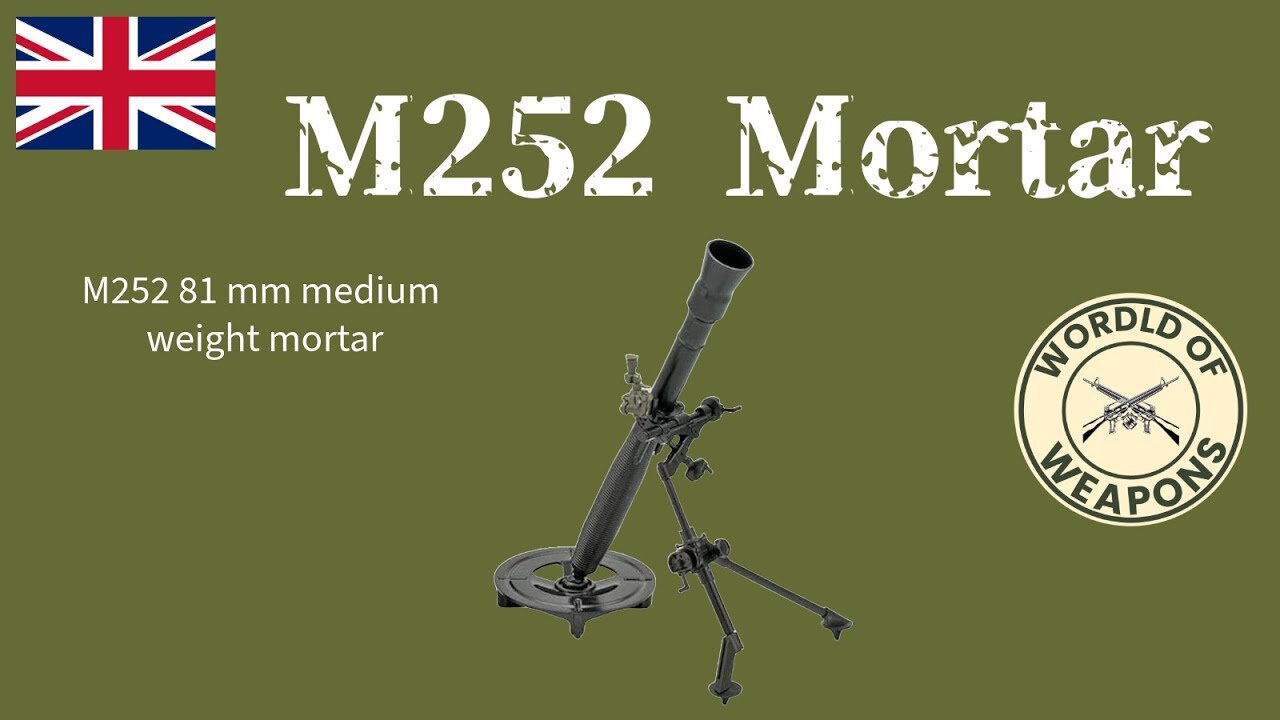Premium Only Content

M252 Mortar 🇬🇧 Versatility and firepower on the battlefield
M252 81 mm medium weight mortar
1.Introduction 00:00
2.Design 00:35
3.History 02:15
4.Method of propulsion 04:03
The M252 81 mm medium weight mortar is a British-designed smooth bore, muzzle-loading, highangle-of-fire weapon used for long-range indirect fire support to light infantry, air assault, and airborne units across the entire front of a battalion zone of influence. In the U.S. Army and U.S. Marine Corps, it is normally deployed in the mortar platoon of an infantry battalion.
Design:
The M252 system weighs 91 lb (41 kg) completely assembled and is composed of the M253 Cannon (35 lb, 16 kg), M177 Mount (27 lb, 12 kg), M3A1 Baseplate (29 lb, 13 kg), and the M64A1 Sight Unit (2.5 lb, 1.1 kg). The mount consists of a base plate and a bipod, which is provided with
screw type elevating and traversing mechanisms to elevate / traverse the mortar. The M64A1 sight unit (also used on the M224) is attached to the bipod mount. The M252 is a gravityfired smoothbore system. Attached to the muzzle of the weapon is the Blast Attenuation Device (BAD), used to reduce the blast effects on the mortar crew. To increase cooling efficiency, the breech end is finned; though first-hand accounts attest that the level of cooling is negligible. The cannon also has a crew-removable breech plug and firing pin.
High explosive rounds fired by the M252 weigh 10 lb (4.5 kg) and can have an effective kill radius of 35 m (115 ft). In 2017, the Marines revealed they were developing precision-guided rounds for the 81 mm mortar, similar to efforts for the 120 mm Expeditionary Fire Support System but in a man-portable system.
History:
The M252 is an adaptation of the British 81mm L16A2 mortar developed in the 1950s. It entered service with the U.S. Army and replaced the previous 81 mm M29 mortar in 1987. It was adopted due to the extended range (from 4,500 meters to 5,650 meters) and enhanced lethality. In the U.S. it
is produced by Watervliet Arsenal.
A lightweight version, the M252A1 was first fielded in December 2014. By using lightweight materials such as aluminum, titanium and nylon kevlar the total weight was reduced by 12 pounds (5.4 kg) to 79 pounds (36 kg). The M252A1 also required less maintenance with its internal gears greaseless. The M252A1 was scheduled to replace the M252 in 2016. In November 2016, the Watervliet Arsenal received a contract to produce the bipods which have an A-shaped bipod frame with deliveries to be
completed by March 2020. As part of the same program, a lightweight version of the M224 60mm mortar the M224A1 was also developed. The Marines developed an improved M252A2 version that weighs about 8.16 kg (18 pounds) less than the original and incorporates a 4× magnification sight with a new cooling system.
Method of propulsion:
The range of a mortar is controlled by the number of propellant charges attached to the tail of the mortar designated M223. A charge is a semi-circular donut of nitrocellulose, which resembles a "horseshoe". A round for the M252 mortar comes with four charges attached. Longer-range shots
require more propellant than can fit in the tail of the round, hence the necessity of external charges.
When the target is ranged, a mortar team member adjusts the amount of propellant by removing horseshoe charges from the projectile. The mortar squad leader verifies the number of charges; then the assistant gunner drops the round down the muzzle of the tube. The round, pulled by gravity,
accelerates down the smooth bore of the mortar until the primer (in the base of the tail boom of the round) strikes the firing pin located in the bottom of the mortar tail assembly. The primer detonates, igniting the charge in the tail fin, which in turn ignites the horseshoes charges on the round. The charges deflagrate, releasing hot, expanding gas which pushes against the round with the obturating ring on the projectile, sealing the gas behind the projectile. The pressure from the expanding gas accelerates the projectile until it leaves the end of the tube.
-

Twins Pod
6 hours agoEMERGENCY PODCAST WITH ANDREW TATE! - Twins Pod - Special Episode - Andrew Tate
53K16 -
 DVR
DVR
Jewels Jones Live ®
2 days agoTRUMP SECURES BORDER | A Political Rendezvous - Ep. 113
25.4K22 -
 25:02
25:02
marcushouse
18 hours ago $33.41 earnedStarship Just Exploded 💥 What Went Wrong This Time?!
93K46 -
 12:00
12:00
Silver Dragons
1 day agoBullion Dealer Reveals Best Silver to Buy With $1,000
50.9K7 -
 12:58
12:58
NinjaGamblers
9 hours ago $11.09 earnedIs This The BEST Way to Win At Roulette? 😲
83.4K7 -
 1:01:54
1:01:54
CharLee Simons Presents Do Not Talk
2 days agoCALIFORNIA'S DONE!
52.3K23 -
 7:33
7:33
MudandMunitions
1 day agoUnboxing My FIRST Revolver! Smith & Wesson 442 .38 Special and What’s Coming Next for the Channel
74K8 -
 1:01:05
1:01:05
Trumpet Daily
1 day ago $9.07 earnedGermany Started Two World Wars and Now Wants Nuclear Weapons - Trumpet Daily | Mar. 7, 2025
59.9K73 -
 57:07
57:07
Stephen Gardner
23 hours ago🚨BREAKING: Musk STUNS even Trump with LATEST FRAUD DISCOVERY!!
188K427 -
 2:26:47
2:26:47
FreshandFit
19 hours agoRatchet Chick Gets Kicked Out "Gracefully" For THIS...
182K196